If you find yourself in an oak grove, you will not be left without mushrooms. What mushrooms that grow under oak trees, and what on oaks
Edible mushrooms that grow on oak trees are some of the most delicious and unique found in the forest. The mycelium of these mushrooms grows down into the nutrient-rich soil below the tree’s bark. These oak mushrooms have a wide variety of flavors, from mild to earthy and spicy..
In this guide, we will tell you about some of the most notable varieties of mushrooms that grow under oak trees, from the earthy Milkcaps mushrooms to the aromatic Lactarius Zonarius. Whether you’re a seasoned forager or just beginning your mushroom-hunting journey, join us as we delve into the world of mushrooms that call oak trees home.
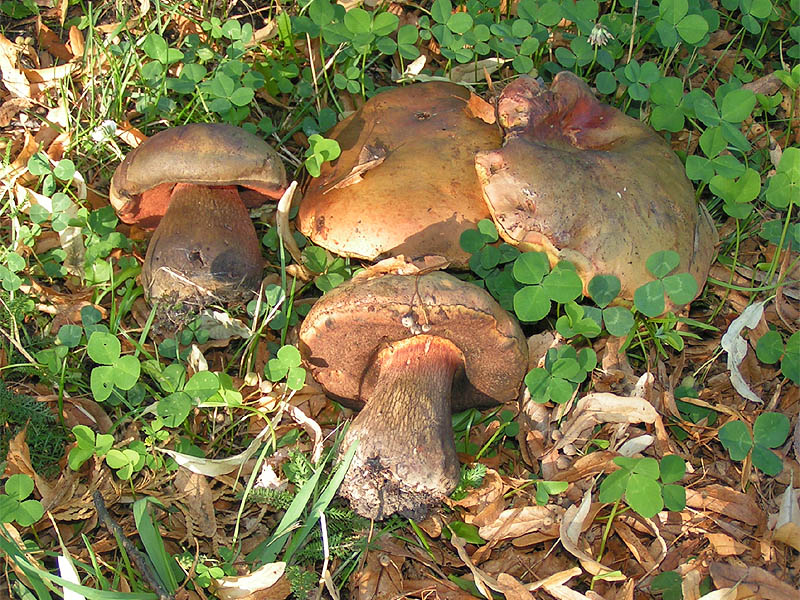
What mushrooms grow on oak trees
Table of Contents
17 Mushrooms That Grow Under Oak Trees
Edible mushrooms that grow on oak trees and under oak trees are renowned for their robust and earthy taste, making them sought after by enthusiasts.
Here’s a list of some notable varieties of Oak Trees Mushrooms:
- Milkcaps mushrooms
- Lactarius fuliginosus
- Lactarius citriolens
- Lactarius azonites
- Lactarius acerrimus
- Lactarius pallidus
- Russula aeruginea
- Russula amethyst
- Russula bluish
- Russula delica
- Russula mustelina
- Russula fellea
- Russula xerampelina
- Russula virescens
- Lactarius hygrophoroides
- Lactarius zonarius
- Lactarius deliciosus
- Lactarius mellow
Milkcaps the Oak mushrooms
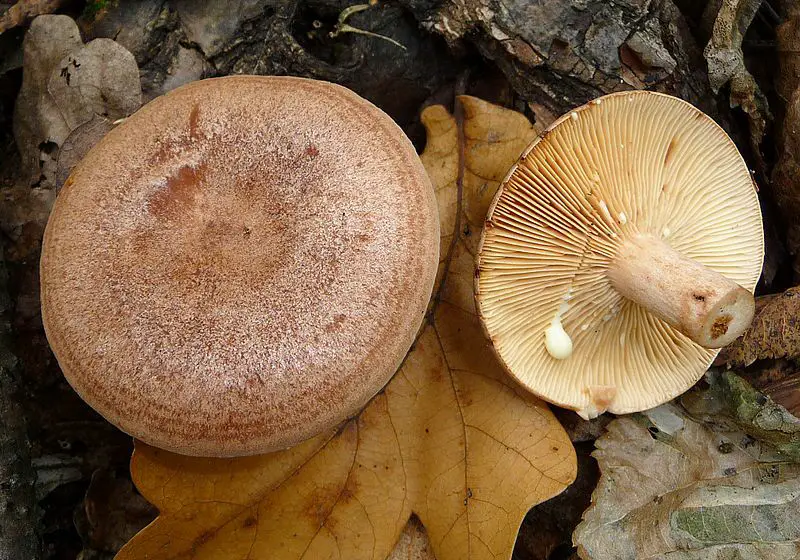
Milkcaps mushrooms, known for their affinity to oak trees, offer a fascinating glimpse into the world of fungi. Here’s what you need to know about these intriguing mushrooms.
Characteristics
- Cap: Ranging from 4 to 8 cm, initially flat-convex before becoming concave with age.
- Stem: Cylindrical, 3-6 cm in height, and 0.5-1 cm in diameter, initially solid then hollowing out.
- Flesh: Dense, brittle, with a distinctive hay smell and mild taste.
- Juice: Milky, non-caustic, watery-white, and remains unchanged upon exposure to air.
- Coloration: Cap ranges from brick-buff to light brownish, while plates darken with age.
Habitat and Season
- Mycorrhiza: Exclusively with oak trees, found in broad-leaved and mixed forests, grassy areas, and litter.
- Fruiting Season: July to September, peak abundance from late July to mid-September.
Similar Species
- Serushka (Lactarius flexuosus): Distinguished by buffy plates and a gray-pink or gray hat.
- Milky Milky (Lactarius serifluus): Similar but with a stronger smell and darker cap.
Check details about Mushrooms that grow on and under birch Trees.
Lactarius fuliginosus: Milky brownish, milky dark brown, sooty milky
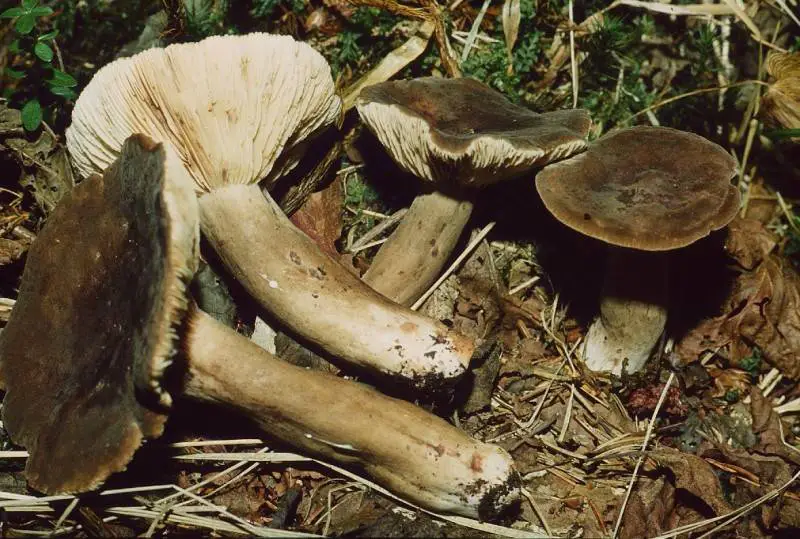
Milkcaps Oak mushrooms, also known as Lactarius mushrooms, thrive under and on oak trees, adding a touch of natural wonder to wooded landscapes.
Characteristics:
- Size and Appearance: Hats measure 4-8 cm, initially flat-convex, later becoming concave. Dry, brownish skin with darker concentric zones.
- Features: Frequent, narrow plates; cream to pink spore powder; cylindrical legs, becoming hollow.
- Flesh: Dense, brittle, whitish to brownish, emitting a distinctive hay scent.
- Juice: Watery-white, non-caustic milky juice.
Edibility:
Conditionally edible but not widely sought after.
Habitat and Season:
- Habitat: Mycorrhiza with oak trees, often in broad-leaved and mixed forests.
- Season: Abundant from July to September, peaking in late July and mid-August to mid-September.
Season: July – mid-September.
Similar Species:
- Other lactifers with a dark brown cap and pinkish milky sap are found under coniferous trees:
- Resinous black milky (Lactarius picinus)
- Brown milky milky (Lactarius lignyotus) is darker, the stem is longer, the plates are wider, it changes color more slowly.
- Lactarius pterosporus with brighter cap and ribbed spores.
lactarius citriolens Oak mushrooms
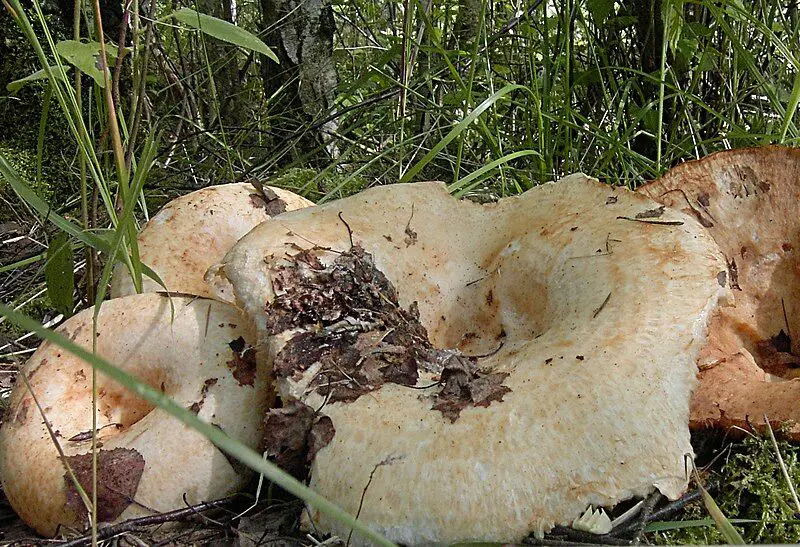
Lactarius citriolens, a fascinating member of the Lactarius genus, presents a captivating profile with its distinct features and peculiarities.
Characteristics:
- Size and Appearance: Caps reach 10-20 cm, convex with a noticeable depression. Yellowish
- Flesh: The flesh is fleshy, tough, fragile like all members of the family, pale yellow, sometimes pinkish in the stem. The milky juice is white at first, turning noticeably yellow in air, with a pungent, pungent taste, with a fruity odor sometimes described as that of an “overripe lemon.” Upon contact with a solution of KOH, the pulp becomes egg-yellow, the milky juice becomes orange.
- Stem: Leg strong, cylindrical or tapering downwards, 4-8 cm long and 2-4.5 cm in diameter, hollow with age. The surface is colored in yellowish-yellow tones, sometimes with a few inconspicuous darker spots at the base, in young mushrooms it is velvety-hairy, this characteristic feature usually remains in adult mushrooms only at the base.
- Spore Print: The spore print is pale ocher, often pale pinkish. Spores 7.5-8.5 x 6 µm, broadly elliptical to almost spherical, with a well-defined reticulate pattern and a few isolated warts.
Edibility:
Like many lactic mushrooms, it is considered an inedible or conditionally edible mushroom, it has a bitter taste that requires a long soaking when salting.
Similar Species of Lactarius Mushrooms:
- The most characteristic features of the fringed mushroom are strong flesh, a noticeable dry “fringe” along the edge of the cap and the base of the stem, which is hairy even in adult mushrooms. The most related European species are Lactarius scrobiculatus, Lactarius aquizonatus, Lactarius resimus, Lactarius auriolla, Lactarius leonis, Lactarius intermedius, Lactarius olivinus and Lactarius tuomikoskii. Of these, it is easiest to confuse this species with L. aquizonatus and L. resimus, also growing under deciduous trees.
- Lactarius aquizonatus Kytöv., 1984 grows in coniferous and deciduous forests with birch, pine, willow or aspen. It is distinguished by watery zones closer to the edge of the cap, moist fringed fibers along the edge, sometimes disappearing with age, more pronounced spots on the stem and the absence of pubescence at its base.
- Lactarius resimus (Fr.) Fr., 1838 – The real mushroom – grows in various types of forest, often with birch or pine. It is distinguished by a short “fringe” along the edge of the cap, which soon disappears, a smooth, sticky surface of the cap that remains white for a long time, and the absence of a hairy base of the stem.
- Lactarius pubescens (Schrad.) Fr., 1838 – White volnushka – found under a birch. The milky juice of this species does not change color in the air. The cap is noticeably fibrous, with long, intertwining hairs on the margin. The stalk is white, often with an orange or pinkish area.
- Widespread in Europe, but rare everywhere. It forms mycorrhiza with birch, oak, beech, hornbeam, hazel, and is also found in mixed forests.
Top Mushrooms Growing on Tree Stump with pictures and names.
Lactarius azonites
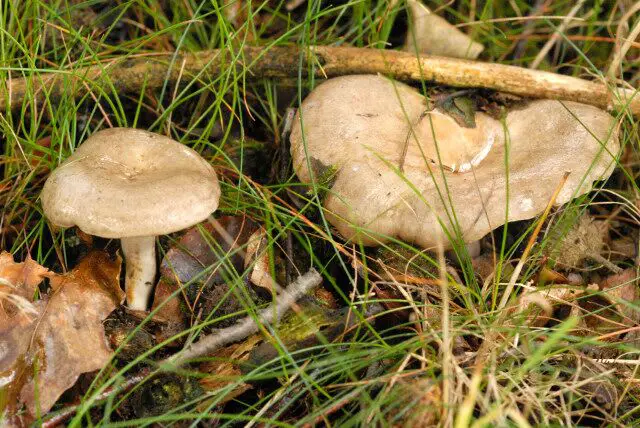
Lactarius azonites Oak mushrooms, a hidden gem in the forest, boasts distinct features for enthusiasts to uncover:
Characteristics:
- Cap: Diameter ranges from 3 to 9 cm, flat or depressed with a central tubercle and smooth edges. Dry, velvety skin varies from brown to sandy hues.
- Plates: Descending, narrow, creamy, darkening with age. Basidia measure 35-42×13-14.5 µm, while fusiform cystids range from 52-66×12-16.5 µm.
- Spores: Cream or light ocher powder, with spores measuring 8-10 × 6.5-8 µm, featuring spinal ornamentation with ridges up to 3 µm high.
- Stem: Height of 3-7 cm, diameter up to 1 cm, cylindrical, hard, naked, matching the cap’s color or lighter to white.
- Flesh: Initially white, dense, and fresh, turning sharp over time, devoid of scent.
- Milky Juice: Initially white, transitioning to orange-pink upon exposure to air.
Habitat and Season:
Found in broad-leaved and mixed forests with oak, aspen, birch, often appearing in large groups across Eurasia.
Lactarius acerrimus
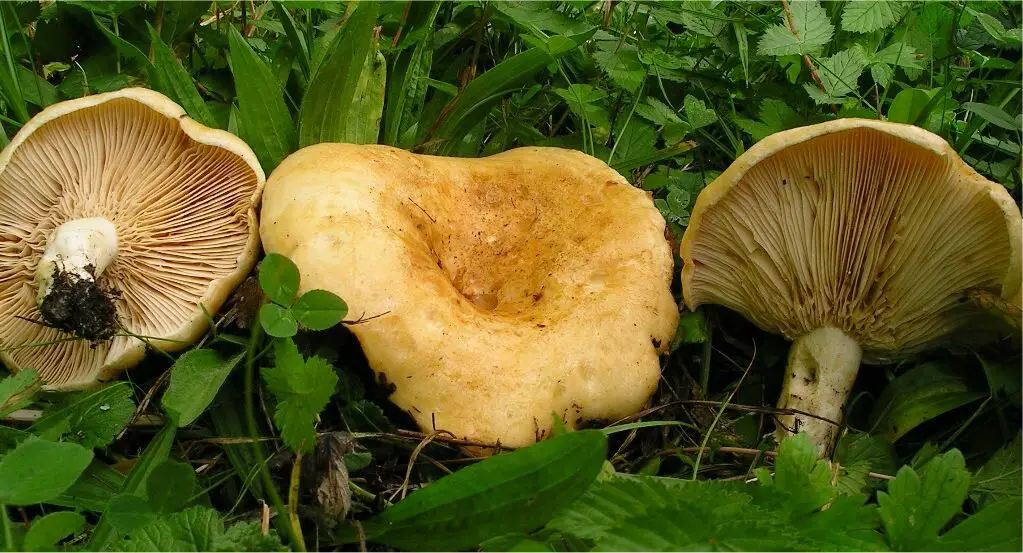
Lactarius acerrimus, a fascinating specimen in the world of fungi, offers an array of intriguing characteristics:
Characteristics:
- Cap: Ranging from 2 to 10 cm, smooth and concave in mature specimens, with a slightly wavy edge. The skin is moist in wet conditions, exhibiting various shades of ocher, darker at the center, adorned with pronounced concentric zones.
- Plates: Relatively sparse and thin, featuring anastomoses, slightly descending, and matching the cap’s color but lighter.
- Spore Powder: Ocher in color.
- Stem: Up to 10 cm tall and 1.5 cm in diameter, cylindrical and hollow, hard, bare, and wet in damp weather. Its smooth surface contrasts with the cap, appearing lighter.
- Flesh: Dense, white, and sharp, lacking any discernible odor.
- Milky Juice: White and remains unchanged upon exposure to air.
Habitat:
Lactarius acerrimus thrives in broad-leaved forests, particularly under oak trees, providing ample opportunities for observation and study.
Lactarius pallidus: Milky pale, milky pale yellow
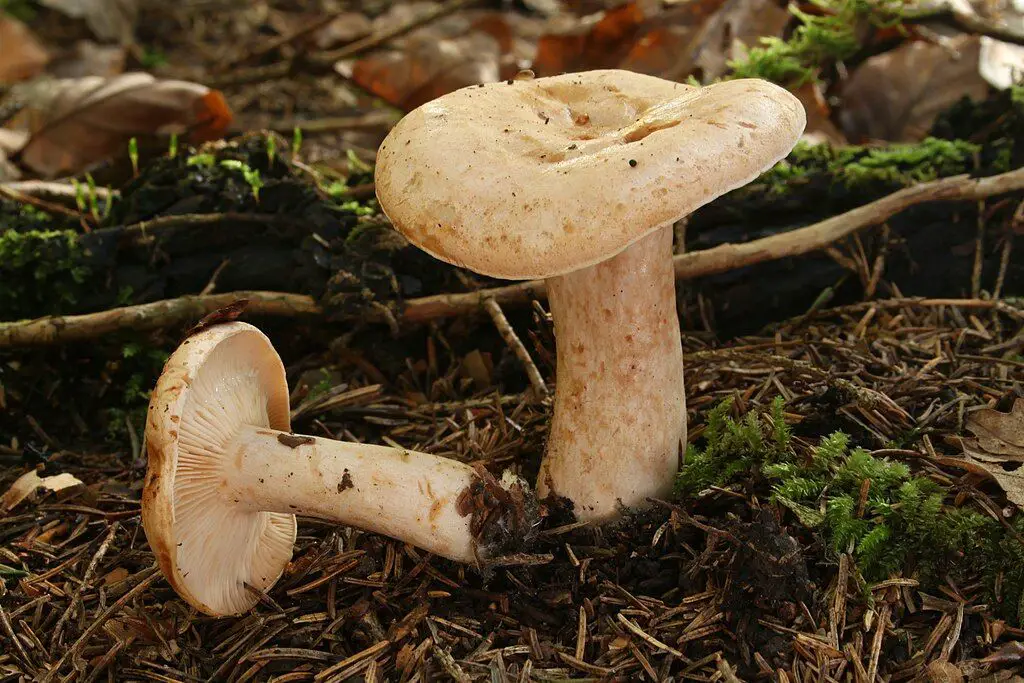
Lactarius pallidus, commonly known for its milky pale yellow appearance, offers an intriguing subject for mushroom enthusiasts.
Characteristics:
- Hat: Convex, then funnel-depressed, with smooth, slimy, pale buffy-yellow skin.
- Plates: Descending along the stem, sometimes branched, matching the cap’s color.
- Spore Powder: Pale buff, with spores almost round, spiny, and amyloid.
- Leg: Cylindrical, hollow, matching cap color, with a smooth texture.
- Flesh: Thick, white or creamy, with a pleasant smell and slightly spicy taste.
- Milky Juice: Plentiful, initially tasteless, turning sharp, and retaining its color in the air.
Habitat and Season:
Forms mycorrhiza with oak, beech, found rarely in oak forests and mixed deciduous forests, in small groups.
Season: July – August.
Similar species:
- Sticky milkweed (Lactarius blennius) – conditionally edible, the milky juice darkens when dried, the fungus grows under birch trees.
- Lactarius curtus has a burning milky juice.
- Conditionally edible mushroom. It is used in salt form along with other mushrooms. Described in some reference books as inedible or suspect.
Best Mushrooms that grow Underground.
Russula aeruginea
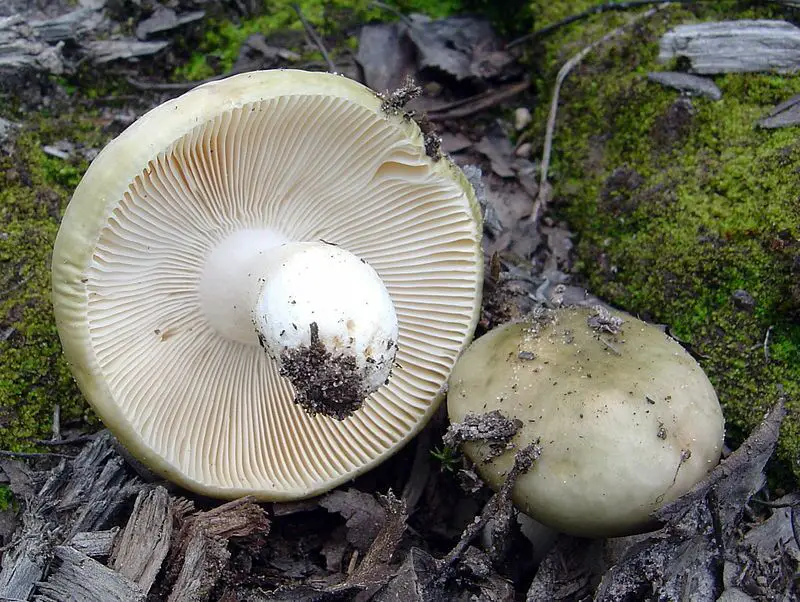
Russula aeruginea, a captivating mushroom species found in the lush forests of Europe.
Characteristics:
- Cap: 4-14 cm in diameter, initially convex, later flattened, grass-green to yellowish-brown.
- Plates: Initially frequent, fragile, diverging, almost free from the stem.
- Stem: Cylindrical, white, developing brownish spots.
- Flesh: Strong, white turning yellowish, sweetish taste, pungent plates, subtle smell.
- Spore Powder: Cream-colored, elliptical spores with warty texture.
Habitat and Distribution:
Thriving in deciduous and mixed forests of Europe, forming mycorrhiza with drooping birch and downy birch.
Similar Species:
- Russula anatina
- Russula subterfurcata
- Russula pseudoaeruginea
Edibility:
Considered edible with a pleasant non-bitter taste.
Russula amethyst, Russula bluish
ussula amethyst and Russula bluish, two captivating mushroom species gracing the forests of the Northern Hemisphere.
Characteristics:
- Cap: Thin, hemispherical in youth, flattening to 4-7 (10) cm in diameter, ribbed edge, wine-brown and purple hues with a dark annular zone.
- Plates: Adherent to the stem, medium-frequent, buffy.
- Stem: Fragile, tapering downwards, quickly hollow, changing from white to yellowish and brownish.
- Flesh: Brittle, white or stem-colored, with a subtle odor reminiscent of iodoform.
- Spore Print: Intense yellow.
Edibility:
Considered edible, forming mycorrhiza with deciduous and coniferous species like oak and spruce. Appears in late summer-early autumn in groups.
Habitat:
Widely distributed in the temperate zone of the Northern Hemisphere.
List of top Trees under which Mushrooms Grow with pictures.
Russula delica
Russula delica, a mushroom species widely distributed across Eurasia’s diverse forests, including those surrounding oak trees.
Characteristics:
- Cap: 5-18 cm in diameter, convex to funnel-shaped, whitish with dark yellowish or reddish-brown zones, often cracking in dry weather.
- Plates: Usually frequent, cream with bluish tinges, sometimes with brownish spots.
- Stem: Very strong, white, often bluish in the upper part.
- Flesh: Strong, white, with a sharp taste and noticeable smell reminiscent of Milky species.
- Spore Powder: White or light cream.
Edibility and Habitat:
Edible but with a rather bland taste. Found mainly on the edges of coniferous, deciduous, and mixed forests, often under birch, oak, beech, spruce, pine, alder, or aspen.
Russula mustelina
the robust and flavorful Russula mustelina, a mushroom species thriving in the mountainous coniferous forests of Eurasia and North America.
Characteristics:
- Cap: 5-14 cm in diameter, initially hemispherical, then convex to slightly depressed, ocher-brown with wine-red zones.
- Plates: Frequent, cream or light ocher, with rusty-brown spots in old mushrooms, adhering to the stem.
- Stem: Cylindrical or obverse-conical, very strong, white turning slightly brown with age, often with characteristic cavities.
- Flesh: Strong, white, turning yellow or brown with age, with a sweetish taste and a cheesy smell in dry weather.
- Spore Powder: Light cream.
Edibility and Habitat:
Edible with a pleasant taste. Widely distributed in mountain coniferous forests, forming mycorrhiza with spruce, occasionally with oak.
Similar species:
- Sometimes smooth-skinned russula looks like a valui, but it has an unpleasant odor, pungent taste, and a hat with a ribbed edge.
Russula fellea
Russula fellea, a mushroom species widely distributed across Eurasia’s diverse forests.
Characteristics:
- Cap: 5-11 cm in diameter, thinly fleshy, initially convex, then flattened-depressed with a furrowed edge. Dark purple or brick red, sticky in wet weather, becoming paler.
- Plates: Quite frequent, branching near the stem, white to light cream.
- Stem: Usually cylindrical or fusiform, spongy and hollow, strongly yellowing when damaged.
- Flesh: Very brittle, white, strongly yellowing in the air, sweetish taste.
- Spore Powder: Cream-colored.
Similar species:
- Russula elegans Bres., 1882 grows under poplar, turns yellow slightly.
- Russula nitida (Pers.) Fr., 1838 grows under a birch, almost does not turn yellow when damaged, well defined by a noticeably radially furrowed edge.
- Russula odorata Romagn., 1950 grows in the oak forests of the Mediterranean, more fleshy, with a strong fruity smell.
- Russula puellula Ebbesen, FHMøller & Jul.Schäff., 1937 grows under beech, does not turn yellow.
- Russula versicolor Jul.Schäff., 1931 is the closest species, also turning yellow when damaged, growing under birch and alder.
The species is widely distributed throughout Eurasia, forms mycorrhiza with both coniferous and deciduous trees, is common, and most often found under spruce, also under pine, fir, beech, and oak.
Russula xerampelina
Russula Xerampelina, a highly valued oak mushroom species widely distributed across Eurasia’s broad-leaved forests.
Characteristics:
- Cap: 5-11 cm in diameter, initially hemispherical, then convex and flattened-depressed, with diverse coloration ranging from wine-red to pure white.
- Plates: Quite frequent, often branching near the stem, white to light cream.
- Stem: Usually cylindrical, strong, white with occasional yellow-brown base.
- Flesh: Strong, with corresponding shade under the skin, slight nutty taste.
- Spore Powder: White, with ovate, finely warty spores.
Edibility and Habitat:
Edible and highly valued, Russula xerampelina grows mainly under coniferous trees, preferring broad-leaved forests with oak, beech, and other species.
Russula virescens
Russula virescens, a highly valued mushroom species widely distributed across Eurasia’s broad-leaved forests.
Characteristics:
- Cap: 5-15 cm in diameter, initially hemispherical, then convex and flattened-depressed, ranging from gray-green to dark green with buffy zones, cracked peel.
- Plates: Quite frequent, often intertwined near the stem, cream with brownish spots, almost free from the stem.
- Stem: Usually cylindrical, strong, white with occasional reddish-brown hues, lower part may crack into brownish scales.
- Flesh: Strong, white, with slight sweetish or nutty taste, very slight smell, pinkish or pink-brown reaction to iron(II) sulfate.
- Spore Powder: White.
Edibility and Habitat:
Edible and highly valued, Russula virescens thrives in broad-leaved forests with oak, beech, and other species.
Similar species:
- Russula parvovirescens Buyck, D.Mitch. & Parrent, 2006 native to eastern North America with a bluish-green cap.
- Russula subgraminicolor Murrill, 1943 is known from the southeast of North America; it differs only in its inconspicuously cracking cap.
The species is widely distributed throughout Eurasia, preferring broad-leaved forests with oak, beech and other species.
Lactarius hygrophoroides
Lactarius Hygrophoroides, an edible oak tree mushroom species thriving in forest habitats.
Characteristics:
- Cap: 4-8 cm in diameter, dry, initially convex then flat or depressed, orange-brown.
- Plates: Rare, white or cream-colored, with protruding milky juice, descending.
- Spore Powder: White.
- Stem: 0.5-1.5 cm in diameter, 3-7 cm tall, orange-brown.
- Flesh: Brittle, white, with milky juice that remains unchanged on exposure.
Edibility and Habitat:
Edible and delicious, Lactarius hygrophoroides forms mycorrhiza mainly with oak trees and is commonly found in forests.
Similar Species:
- Lactarius corrugis: Features a red-brown cap with a wrinkled edge, buffy plates, and milky juice that turns brown upon exposure to air.
- Lactarius volemus: Identified by its red-brown coloration.
Embark on a culinary adventure with this delightful forest mushroom.
Lactarius zonarius
Lactarius Zonarius, a delightful oak mushroom species found in deciduous and mixed forests.
Characteristics:
- Cap: Dry, yellow-orange, adorned with characteristic concentric circles.
- Plates: Slightly descending to the stem, frequent, yellowish.
- Stem: Yellow-brown.
- Flesh: Whitish, with a fruity smell and a burning taste.
- Spore Powder: Ocher.
Habitat and Season:
Lactarius zonarius thrives in deciduous and mixed forests, particularly near oak trees. It graces the forest floor during the autumn season.
Culinary Uses:
Although it requires soaking and salting, Lactarius zonarius is edible and offers a delightful addition to autumn dishes.
lactarius deliciosus
Lactarius deliciosus Mushrooms that grow on oak trees, a mushroom species with diverse characteristics and culinary uses.
Characteristics:
- Cap: 3-7 cm in diameter, dense and brittle, brown with a matte, smooth, or slightly wrinkled surface.
- Flesh: Brittle, with a slight unpleasant odor and bitter taste, secreting watery-white milky juice upon cutting.
- Plates: Frequent, narrow, slightly descending, initially whitish, turning light brown with a pink tint.
- Stem: 3-7 cm in height, cylindrical with longitudinal fleecy stripes, varying in color from rusty red to dark brown.
- Spore Powder: Cream to pinkish, with round, reticulate spores.
Habitat and Season:
Lactarius deliciosus forms mycorrhiza with deciduous trees, particularly beech and oak, thriving in deciduous forests from July to October, with peak abundance in late August and late September.
Similar Species:
- Lactarius rufus: Distinguished by its darker burgundy color and non-caustic milky juice.
- Lactarius volemus: Larger in size with a fleshy texture and abundant milky juice.
Culinary Uses:
While considered conditionally edible, Lactarius deliciosus is often salted or pickled, offering a unique culinary experience despite its bitterness.
Lactarius mellow
Lactarius Mellow, a delicate oak tree mushroom species found in oak tree habitats.
Characteristics:
- Cap: 2-6 cm in diameter, initially convex then funnel-shaped with a small tubercle, apricot skin, velvety, dry.
- Plates: Adherent or descending, thin, cream-colored, sometimes with reddish spots.
- Spore Powder: Creamy pink, with ornamented, amyloid spores.
- Stem: 3-8 cm in height, cylindrical, initially dense then hollow, matching the color of the cap.
- Flesh: Dense, orange, pale yellow, or pale orange under the skin, with mild odor.
- Milky Juice: White, watery, non-caustic, doesn’t change color in the air.
Habitat and Season:
Forms mycorrhiza primarily with birch, occasionally with oak and spruce, found in moss and on litter, appearing from mid-July to October, with peak abundance in August and September.
Similar Species:
- Brownish Milkweed (Lactarius fuliginosus): Distinguished by darker cap and stem, thin flesh, long stem, and different habitat.
- Lactarius fulvissimus: Larger, reddish-orange, with a sharp unpleasant odor.
Culinary Uses:
Considered conditionally edible, often used salted or pickled, though it’s often considered inedible in Europe due to low quality.
ediblity:
While not prized for its taste, Lactarius mellow offers insights into the intricate relationships within forest ecosystems.
Conditionally edible oak tree mushroom of low quality used salted or pickled.
Conclusion
In conclusion, mushrooms that grow under oak trees and also on oak tree are a great way to get introduced to the hobby of mushroom hunting. They are easy to find, and their taste is mild. Make sure you are aware of the poisonous mushrooms that may look similar, and always consult a guide before eating any mushrooms you find.
